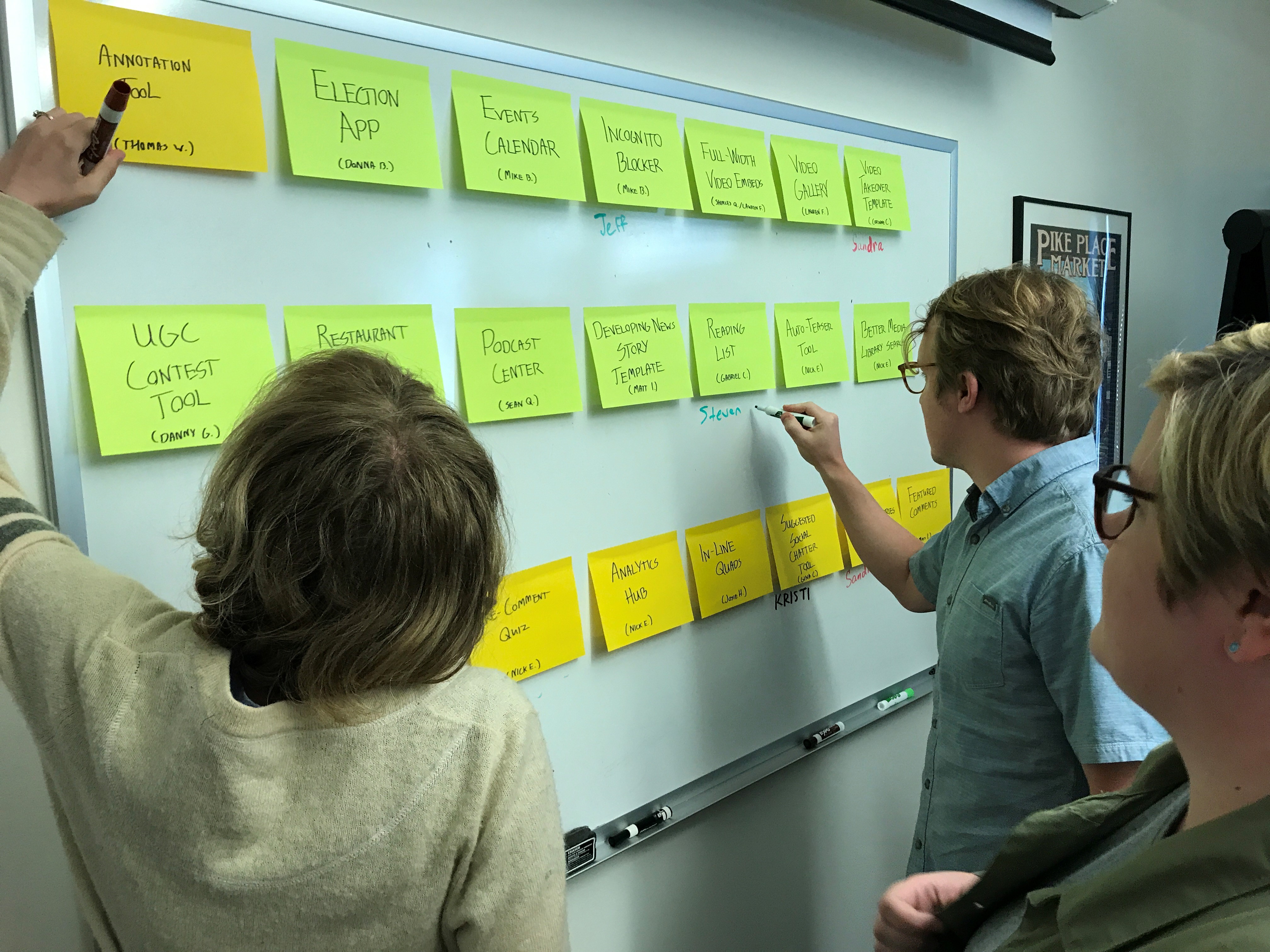One Monday last June, a few teams at The Seattle Times got together to sift through about 30 ideas they’d collected from the newsroom for a hack week.
In an off-white conference room with exposed ductwork and windows looking out on Seattle’s Denny Way, the product, software development and user experience teams scribbled ideas onto big neon yellow and orange sticky notes.
They included: election app, podcast center, UGC contest tool, events calendar and analytics hub.
Nick Eaton, digital audience editor, asked for that last one. Could the developers build a dashboard, he wondered, that was actually easy to use and brought all the data that’s available into one place? Could they build a single tool that more clearly answered the question: How’s my story doing?
Newsrooms have tracked audience for years now. But what if they’ve been watching the wrong numbers, or, perhaps, not all the right numbers?
That hack week last summer produced the hub, and the Times has been tweaking it ever since. What they think they’ve come up with is a measurement that moves journalism analytics beyond the pageview hunt.
Now, the newsroom can see if their stories are actually turning readers into subscribers.

The influence report
The Times’ in-house analytics hub measures all the things most analytics tools measure, but it also looks at the work that leads people to pay for journalism.
The team that built it includes Josh Hart, a mobile product manager, David Parks, a data analyst engineer, and Steven Speicher, a software engineer. They tapped into data from Google Analytics, Chartbeat, LiveFyre and Crowdtangle.
Here’s how it works:
Digital subscriptions are measured by something called the “influence report.” That report produces a score based on what users clicked on before becoming subscribers over three sets of time periods. The time periods are:
-
One visit (people click on more than one story per visit)
-
One week and five pageviews
-
Thirty days and 25 pageviews
The influencer report can be searched by topic, section and author. The newsroom has started rolling the reports out in beta to various departments.
So far, Mike Rosenberg, a real estate reporter, is seeing that his in-depth and time-consuming work often drives more subscriptions than the work that took an hour but went viral, he said.
Last year, Rosenberg spent a lot of time on a story about how Amazon made Seattle the country’s biggest company town. It ran on the front page on Sunday and influenced 140 subscriptions, more than anything else he’s covered in his two years at the Times.
He also wrote a quick story last year about tiny apartments. It was the most-read story on the day it was published and got about 100,000 pageviews. It influenced about seven people to subscribe.
“The consensus is we’d rather have a story that had a smaller number of good readers who wind up subscribing than a viral story that a bunch of people in New York and Chicago read but will never come back to Seattle again.”
While talking for this story last week, Sharon Chan, vice president of innovation, product and development, opened up the hub to see what it showed about the work that was working.
In the past 30 days, the top five stories that “influenced” digital subscribers — suggesting they prompted some people to sign up and pay — were about a seedy illegal “gingerbread” house in Mount Baker-Snoqualmie Forest, state lawmakers’ attempt to hide from public records, a look at turbulence inside Sinclair-owned KOMO News, rising housing prices and the transformation of a local mall.
A lot of variables lead to people subscribing, Chan said. It’s never really just one story. But those stories that are leading to subscriptions show her a few things:
– People want local, in-depth news.
-They care about government accountability and transparency.
– And they want to know how their region is changing.
“It’s definitely not clickbait,” she said. “This is real journalism that takes hours and days of a reporter’s time to put together.”

The growing movement for digital subscriptions
Subscriptions aren’t this simple roadmap to follow into the land of sustainability. But news organizations are clearly in pursuit, particularly as digital and print revenues continue to fall.
Many U.S. newspapers have made digital subscriptions a focus, including The New York Times, The Washington Post, the Boston Globe, The Dallas Morning News, Gannett’s USA Today Network and McClatchy.
The Seattle Times was part of a Knight-Lenfest Initiative, also known as “Table Stakes,” a project to help metro news organizations transform. (Disclosure: Knight funds my coverage of local news and Lenfest is a funder of Poynter.)
Subsequently, Poynter worked on its own Knight-Lenfest Newsroom Initiative. Fifteen of the 20 newsrooms involved made the drive for digital subscriptions a major element of their ongoing transformation strategy, said Butch Ward, a former Poynter faculty member who helped lead the program.
RELATED TRAINING: Creating an Audience-Focused, Digital-First News Organization: Intro to Table Stakes
Tracking the conversions from reader to subscriber isn’t brand new. But it’s also not that easy. Google Analytics already offers a way to track conversions, said Ryan Nakashima, an AP technology writer who’s working with the Bay Area News Group testing ad-free news experiences. But it’s not a feature in Google Analytics’ default view, he said, and takes tinkering from a developer.
Here’s the question that focusing on digital subscribers should soon answer: Can newsrooms make more money from digital subscribers than from programmatic ad revenue?
If a news site has a paywall, most people see a small sliver of pages, but their clicks generate some money, Nakashima said. But when they subscribe, they’re bringing in ad dollars and subscription dollars.
Both, he said, are important.
In February, the American Press Institute published a study and found nine overlapping paths that lead to people paying for their news. Those include:
-
People who convert because they hit the digital paywall: 21 percent
-
People who are engaged at the local level: 18 percent
-
People who believe in the service journalism provides: 24 percent
In each of the nine cases, different factors may lead a reader to subscribe, said Jeff Sonderman, API’s deputy executive director and a former reporter at Poynter.
A “journalism matters” message will work for some potential readers — but not everyone.
It’s not enough to just put up a paywall, he said. If newsrooms want to build a business model around digital subscriptions, they have to think about the quality of the work they’re investing in and be sophisticated in how they market, target and keep those subscribers. But it can work.
“At a basic level, there’s something really empowering to individual journalists about seeing a specific number of subscriptions that a specific article contributed to,” he said.
There’s not just this general sense that they’re doing quality work, but an understanding of how that work is contributing directly to sustainability.
“And that’s something we just haven’t had in the past.”
So how’s it going now in Seattle?
The Seattle Times started publishing in 1891. Today, it’s owned by the same family, the Blethens, that bought it in 1896. (McClatchy has a minority interest.) Once an afternoon newspaper, it’s now the only daily print publication left in Seattle (although certainly not the only journalism in town.)
Here’s a quick look at the last decade there, which has included multiple layoffs:
-
In 2009, the Seattle Post-Intelligencer stopped printing.
-
In 2011, the Times created its first mobile app.
-
In 2013, the Times added a paywall.
-
In 2015, the Times made big investments into its IT infrastructure and digital subscription platform. It started refining the approach to attract digital subscribers, including with A/B testing. The Times focused relentlessly on subscribers, (which you can dive into more here) and how to turn registered users into them.
In 2017, digital subscribers grew by 50 percent, said Kati Erwert, vice president of marketing and public service. Audience revenue grew by 54 percent. Now, she said, the goal is to be modestly profitable.
The Times includes digital subscriptions with all of its print subscriptions and currently has 32,828 digital-only subscriptions. (Seattle’s population is now more than 700,000.) Their goal is to increase that number by 30 percent in 2018.
“We have a vision for how this can work,” said Don Shelton, executive editor. “Digital subscriptions and Sunday plus digital is what we’re focusing on. That’s an empowering vision for the company and for the newsroom. I think we have something special going on here.”
What matters?
The Times is now measuring something that’s easy for new and veteran journalists to understand, said Eaton, the digital audience editor.
“It’s both analogous to the old print days and it’s deeply tied into our company’s business model,” he said.
Journalists at the Times are just starting to get goals around subscriptions. Many in the newsroom will be expected to increase their own scores by 15 percent, Shelton said. It’s too early to know what a good influencer score is, he said, but people will be competing against their own past work.
In the past six months, Eaton has focused on getting people to think about analytics through daily emails that highlight top stories. Those stories are based on different metrics, including readers and subscribers.
But how do you weight a story with 200 readers that leads to policy change? How does that impact line up with the business goals of growing subscribers?
Editors will have to help the newsroom, Eaton said, with a focus on both, “because obviously there’s a whole lot of value in impact,” he said. “It’s a challenge, but I think it’s a challenge that the whole industry is working on right now.”
How is my story doing?
The Times’ analytics hub was built to address the question “how’s my story doing?” The answer now isn’t just about clicks or time, but the kind of work people want to pay for.
In the past six months, stories that led to subscribers included breaking news, watchdog investigations, and in-depth and contextual reporting about the region.
Even one year ago, the impression here was that the main goal of digital was clicks and the crap you can find anywhere on the internet, said Gina Cole, audience engagement editor.
“I think we’re slowly starting to change the attitude that really great in-depth journalism is antithetic to digital success.”
Clicks still bring in ad revenue and get people to hit the paywall.
“They’re an important thing to look at,” she said. “They’re just not the only thing we look at.”
Correction: An earlier version of this story paraphrased Kati Erwert as saying that the Times is now modestly profitable. That was transcribed incorrectly. She said the goal is to be modestly profitable. We apologize for the error.







